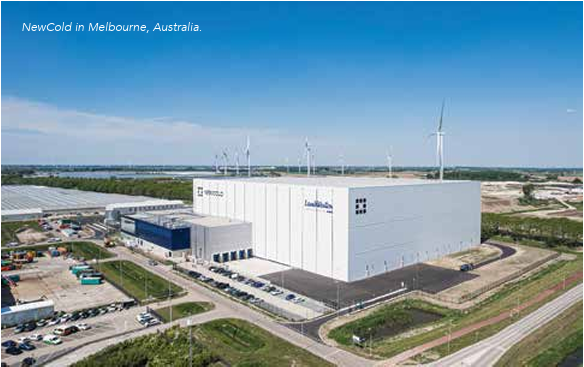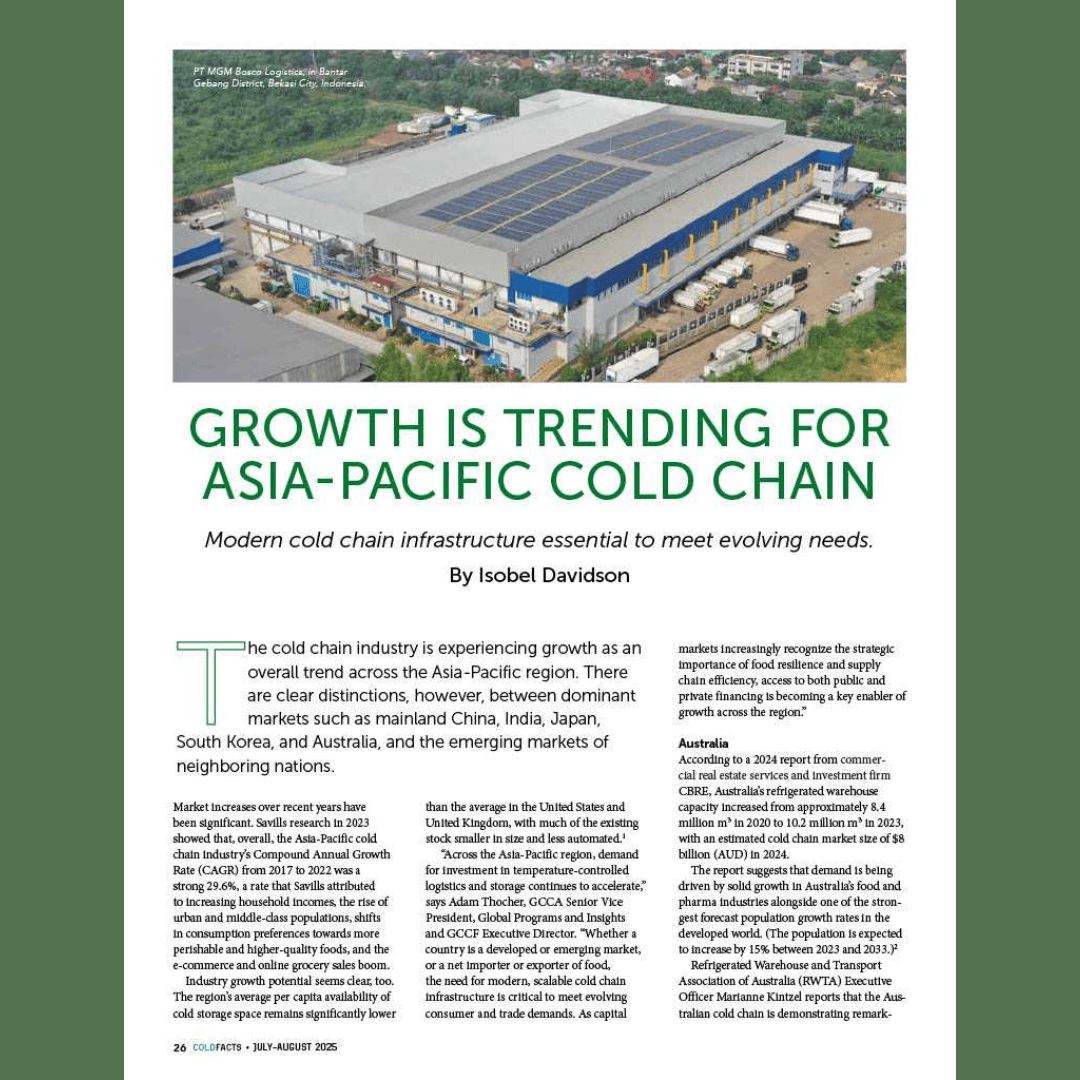Modern Cold-Chain Infrastructure Essential to Meet Evolving Needs
The cold chain industry is experiencing growth as an overall trend across the Asia-Pacific region. There are clear distinctions, however, between dominant markets such as mainland China, India, Japan, South Korea, and Australia, and the emerging markets of neighboring nations.
Market increases over recent years have been significant. Savills research in 2023 showed that, overall, the Asia-Pacific cold chain industry’s Compound Annual Growth Rate (CAGR) from 2017 to 2022 was a strong 29.6%, a rate that Savills attributed to increasing household incomes, the rise of urban and middle-class populations, shifts in consumption preferences towards more perishable and higher-quality foods, and the e-commerce and online grocery sales boom.
Industry growth potential seems clear, too. The region’s average per capita availability of cold storage space remains significantly lower than the average in the United States and United Kingdom, with much of the existing stock smaller in size and less automated.1
“Across the Asia-Pacific region, demand for investment in temperature-controlled logistics and storage continues to accelerate,” says Adam Thocher, GCCA Senior Vice President, Global Programs and Insights and GCCF Executive Director. “Whether a country is a developed or emerging market, or a net importer or exporter of food, the need for modern, scalable cold chain infrastructure is critical to meet evolving consumer and trade demands. As capital markets increasingly recognize the strategic importance of food resilience and supply chain efficiency, access to both public and private financing is becoming a key enabler of growth across the region.”
Australia
According to a 2024 report from commercial real estate services and investment firm CBRE, Australia’s refrigerated warehouse capacity increased from approximately 8.4 million m³ in 2020 to 10.2 million m³ in 2023, with an estimated cold chain market size of $8 billion (AUD) in 2024.
The report suggests that demand is being driven by solid growth in Australia’s food and pharma industries alongside one of the strongest forecast population growth rates in the developed world. (The population is expected to increase by 15% between 2023 and 2033.)2
Refrigerated Warehouse and Transport Association of Australia (RWTA) Executive Officer Marianne Kintzel reports that the Australian cold chain is demonstrating remarkable adaptability in 2025, driven by strong export volumes, diversification efforts, and strategic responses to global trade dynamics.
Japan
In Japan, the population is expected to decrease by 5% between 2023 and 2033. However, CBRE still expects demand to grow in several high-population areas that lack cold chain facilities such as Aichi, Saitama, and Chiba.
Pressure on capacity overall is extremely high. Cold storage usage rates indicate that, by the end of 2024, Tokyo, Yokohama, and Kobe all had usage rates approaching or exceeding 100%. CBRE research reveals that 33% of Japan’s total cold storage floor space is located in facilities that are at least 40 years old, indicating a likely increase in demand for the redevelopment and rebuilding of older facilities.3
South Korea
In marked contrast to Japan, South Korea’s cold storage industry is reportedly experiencing a period of overbuilding. In 2024, new supply for cold storage in South Korea represented only 44% of 2023 levels, and in the leasing market, cold storage rents declined in 2024 due to prolonged vacancies.4
Eunhye Park, Deputy General Manager of the Korea Cold Chain Association, notes that while investment in cold storage warehouses has halted due to oversupply, the focus of current investment is import and export logistics services for fresh agricultural products, and the development of refrigeration equipment using natural refrigerants. Park explains that due to government regulations on High GWP HFCs Refrigerant use, refrigerants used in industrial refrigeration equipment and reefer trucks must have a GWP of 1,500 or less from 2028, and a GWP of 750 or less from 2030.
Singapore
In the emerging cold chain markets of the Asia-Pacific region, capacity is generally very tight, and demand for cold chain services is anticipated to grow significantly over the next decade.
Singapore’s cold chain perishables market is expected to double by 2034, as a rising population and affluence drive increased fresh food consumption. Additionally, e-commerce is expected to double between 2023 and 2030, according to Cushman & Wakefield.
The majority of Singapore’s cold warehouse capacity is currently in western regions close to major seaports like Jurong Port and Tuas Mega Port and in northern regions near the Singapore causeway and Sembawang wharves.5
Philippines
Investment continues in the emerging Philippines market, including I Squared Capital’s recent acquisition of Royal Cold Storage. The global infrastructure investor states that the cold storage sector in the Philippines benefits from strong macro tailwinds. This includes population growth, rapid urbanization, and maturing consumer preferences that are fueling an increasing need for cold chain infrastructure. Double-digit annual growth in the sector is expected over the next decade.
The Philippine government is also investing in the cold chain. In June 2025, the Department of Agriculture announced the allocation of $53 million to build approximately 100 cold storage facilities to extend the shelf life of fruits, vegetables, and other high-value crops.
Indonesia
Indonesia has significant growth opportunities for fulfilment, e-commerce, and last-mile delivery businesses. Start-up companies are emerging with capital from both domestic and international investors, says Hasanuddin Yasni, Chairman of the Indonesia Cold Chain Association.
“As a maritime and archipelagic country, Indonesia faces the challenge of providing nutritious food at affordable prices in all areas. The main trend in demand for cold chain services is in food delivery and storage that can be ordered online,” says Yasni. “Cold package delivery services for food and pharmaceutical products between islands, cold chain facilities at loading, unloading, and transfer ports, and the provision of cold logistics in production areas are the main focus of investment.”
Cold chain operators in Indonesia are innovating to reduce operational energy costs and improve efficiency.
“Solar panels and alternative energy sources are solutions being gradually implemented to support the sustainability of energy needs,” says Yasni. “Digital systems for monitoring the performance and maintenance of refrigeration machinery and equipment, as well as digital storage systems (WMS) and cold delivery systems (TMS), are evolving from various technologies provided by manufacturers and are being developed with appropriate platforms. AI and automation systems are gradually being implemented and are opening opportunities in the near future.”
Yasni states that these technologies have reduced logistics costs as a percentage of GDP from 24% to around 17%, and efforts are underway to further reduce this to 9% to 1% over the next five years.
Regional Challenges
Against this backdrop of overall regional growth, different cold chain markets in the Asia-Pacific region are navigating specific and distinct challenges.
In Korea, some ongoing cold chain development projects have modified their designs to convert cold storage space to dry storage to address persistent vacancy issues caused by the surge in supply in the early 2020s. There are even instances of completed facilities undergoing part conversions from cold to dry storage, such as Bucheon Naedong and Bundang Yatap.
According to a recent Savills market analysis, however, the challenges from oversupply are near-term, and the long-term fundamentals of Korea’s cold chain market remain robust.6
In Australia, the cold chain is grappling with significant structural challenges, particularly within the transport and logistics sector. In June 2025, Don Watson Transport, one of Australia’s best-known refrigerated transport firms, announced its closure after 77 years of operation in a decision attributed to ongoing economic pressures including high operating costs, labor shortages, and slim profit margins.
This closure follows the high-profile liquidation of Scott’s Refrigerated Logistics in early 2023. The RWTA suggests key concerns for the sector include rising costs, unsustainable contract margins, driver shortages, and aging fleets.
“Australia’s cold chain is a vital service, adaptable, and resilient. Export performance in beef, dairy, and seafood remains strong, supported by strategic market diversification,” says Kintzel. “However, the collapse of another major logistics provider highlights the need for industrywide reform. Investments in innovation, workforce capability, and international trade development will be critical to ensuring longterm resilience in our sector.”
Trade
International trade continues to prove a strong opportunity for Australia’s cold chain. Food product manufacturing exports reached $35 billion (AUD) in 2023, up from approximately $18 billion in 2013.7 And in April 2025, Australia exported more than 127,000 tons of beef, a 21% year-on-year increase. Despite the 10% tariff introduced by the U.S. administration, exports from Australia to the United States surged 37% while exports to China climbed 62%.
Australia’s dairy export value rose by 15% over the past year to $3.7 billion, buoyed by demand in key Asian markets, especially China. RWTA reports that in the medium term, demand is expected to stabilize, and lamb exports are expected to soften due to changing dietary trends, heightened competition, and trade normalization.
CBRE anticipates new and emerging markets for Australia’s exports in the Middle East, the United Kingdom, Brazil, and India.
Elsewhere in the region, international trade is central to cold chain growth. Japan’s Ministry of Land, Infrastructure, Transport and Tourism data shows that domestic inbound frozen food stock volume registered a 63% increase between 2011 and 2023. Singapore exports about 60% of locally manufactured food and imports 90% of its food supply.8
“Trading food remains of fundamental importance to economies across the Asia Pacific bloc,” comments Shane Brennan, Senior Vice President Strategy, Partnerships and Policy at GCCA. “Food producers continue to exploit demand for their products, especially the seafood exports of the Association of Southeast Asian Nations and the beef and pork production of Australia.”
“However, there has been some turbulence, mainly a result of the United States’ attempt to reposition its trade balance with markets across the region. The short-term impacts are unpredictable, and in the long term, we can expect efforts to find new trading partners both within the bloc and with a diversified portfolio of markets.”
ENDNOTES
1 Savills – Asia Pacific Cold Storage Markets Spotlight June 2023
2 CBRE report – Australia Cold Chain Logistics 2024
3 CBRE reports – Japan Cold Storage: Expanding the Leasing Market 2025, and Japan Cold Storage Market Overview 2024
4 CBRE report – Capturing the Logistics Opportunity in Japan, Australia and South Korea 2024
5 Cushman & Wakefield – Singapore Cold Chain Report 2024
6 Savills report – Korea Logistics Market Outlook 2025
7 CBRE – Australia Cold Chain Logistics Research 2024
8 Cushman & Wakefield – Singapore Cold Chain Report 2024
Media Contact
For media inquiries, please contact: Lindsay Shelton-Gross, Senior Vice President, Global Communications, Marketing and Strategic Initiatives, Global Cold Chain Alliance.




